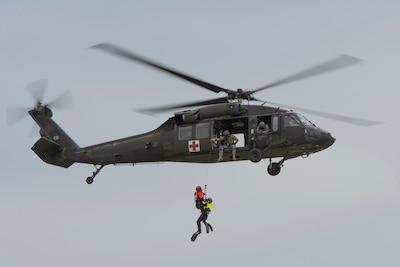By Air Force Airman 1st Class Keith Holcomb 14th Flying
Training Wing
COLUMBUS AIR FORCE BASE, Miss., April 11, 2018 — Air Force
Airman 1st Class Jacob Davis was overweight and the target of bullies
throughout his early high school years.
He decided to make some changes.
“I was tired of being bullied for my weight. I was hanging
around the wrong groups, and I needed to change my lifestyle,” said Davis, an
aviation resource manager with the 14th Student Squadron here.
‘Working Hard, Eating Right’
After his sophomore year in high school, Davis recalled, he
“started working hard and eating right when I could.”
“Now looking back on it, lots of people started encouraging
me at school and at home,” he said. “They were proud of me.”
During his high school senior year, Davis realized he didn’t
want to become stagnant or lose the progress he was making.
“After changing my life around and looking into the Air
Force, I saw they would push me to be better, and it seemed like a good fit,”
he said. “A few of my friends were preparing to be Marines and soldiers, and
they encouraged me to join, too. I didn’t just want to sit around at a
comfortable job and gain all the weight back, so I became very interested in
the military.”
Family Support
Davis’ family, which has a history of military service, was
very supportive of his decision to join the Air Force, he said.
“My parents were helping me and tried to help push me in the
right direction,” Davis said. “My brother was in the Marines, so he was a good
influence, as well. Regardless of the help and the shift in my daily life, it
was definitely an uphill battle.”
He ran almost every day, took up football, lifted weights
with friends and consumed smaller portions of food. And over the next two years
he lost weight.
“There was a lot for me to prove. I lost over 100 pounds to
prepare for basic training, and I when I got there I was proud to be scoring
really high on the physical fitness test,” Davis said.
He said his initial goal was just to complete basic
training, but by the end of it he never scored below a 90 percent out of 100 on
the physical fitness test.
Parents’ Pride
“My first time home after completing basic, my dad reminded
me of how he remembers I couldn’t do a single pushup in the living room,” Davis
said. “When both my parents saw my progress, I think that transformed my
mindset from pride in my progress to pure determination to keep pushing myself
up the hill.”
The effort Davis put into his physical fitness carried over
into other aspects of his life, he said. After completing technical training,
he was assigned here, where he maintains flight records and validates aircrew
safety requirements.
“He works really hard. His work ethic did transfer into his
career,” Air Force Airman 1st Class Amiron Cottman, the squadron’s aviation
resource manager, said of Davis. “Motivation isn’t a question. When I was gone
for two weeks, he took over a lot of the work. It shows in everything he does.”
Davis is always driven to achieve more, Cottman said.
“A lot of what Davis does is to better himself and those
around him,” he added. “People like him for his sense of humor and the energy
he brings every day. He is proof that working hard can get you where you want
to be.”









